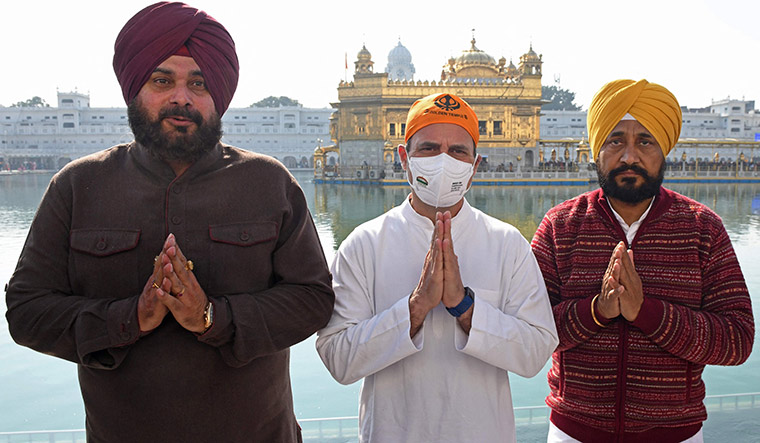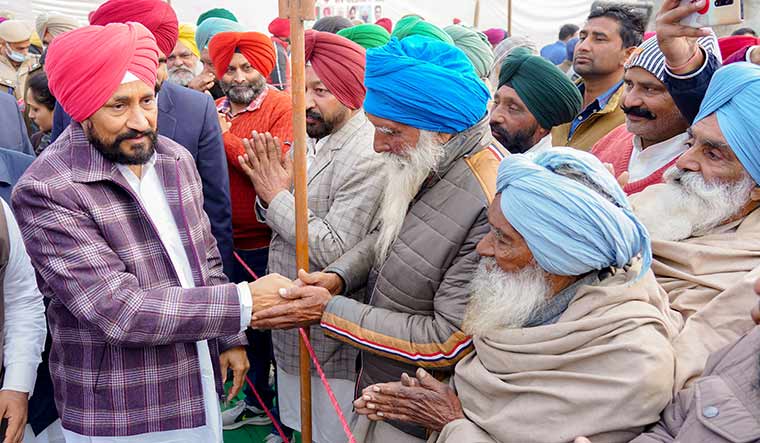Punjab Chief Minister Charanjit Singh Channi has a penchant for accumulating degrees. He has a bachelor's in law and master's degrees in business administration and political science. And now, he is pursuing a doctoral thesis on the Indian National Congress, focusing on the party’s “central organisation and electoral strategies”. The topic could not have been more apt—or, say, more ironic—considering that what Channi proposes to research is exactly what he and his party are grappling with as they endeavour to retain power in the border state.
On September 20, when Channi was sworn in as Punjab’s first dalit chief minister, it was seen as a major disruption in state politics. The mighty Captain Amarinder Singh had been dethroned and replaced by a self-proclaimed aam aadmi (common man). And the appointment of a dalit to the top post in a state where 32 per cent voters belong to the scheduled castes was expected to send the other parties back to the drawing board.
Channi, 58, has played the part of the common man’s chief minister to the hilt, attempting to come across as a leader who has empathy for the woes of citizens, is in touch with the issues that matter at the grassroots, and is willing to take people’s feedback on governance. This was seen as a welcome change from the tenure of Amarinder, who was increasingly being viewed as detached and confined to the ivory tower.
From sitting on the sidewalk outside his official residence in Chandigarh to listen to the grievances of people, to stopping his cavalcade to bless a newly married couple, to breaking into bhangra with students at a college event, to curtailing his security cover, Channi has done all it takes to be seen as approachable and affable. It did not go unnoticed when he held a low-key wedding for his son and was pictured seated on the floor of the gurdwara with guests, partaking of a non-lavish lunch after the ceremony. Channi has projected his humble origins and the struggles of his childhood and youth, talking about helping his father in the latter’s tent house business in the town of Kharar, near Mohali. And in keeping with the common man narrative is Channi's growth trajectory in politics. He rose through the ranks, contesting municipal elections in Kharar, fighting assembly polls from Chamkaur Sahib in 2007, and winning as an independent when the Congress did not give him a ticket, and then winning the seat on party tickets in 2012 and 2017.
“I am the real aam aadmi. This is a government of aam aadmi,”Channi declared at his first press conference after taking charge as chief minister. It was evident that the main task before him was to deal with the challenge posed by the Aam Aadmi Party. A major part of that challenge was to prevent the AAP from cornering dalit votes. While the dalits do not vote en bloc in Punjab, the Congress’s share of the community’s votes was dented by the AAP in the previous assembly polls. In 2017, the AAP had eaten into the Congress’s dalit vote base, more specifically dalit Sikhs.
Channi also had to counter the AAP’s campaign led by Delhi Chief Minister Arvind Kejriwal, which was gaining momentum because of a slew of populist promises and hinged on the perception of the people’s disenchantment with traditional parties.
Channi set a breakneck pace for himself in the 111 days that he was chief minister before the model code of conduct came into effect, touring the state and declaring that he does not sleep nor lets his officers sleep. There was a flurry of populist announcements, which included waiving pending water and electricity bills, slashing power tariff, regularising contractual staff of the government and giving property rights to people living in unauthorised areas.
However, the disruptive move of appointing Channi as chief minister, a rare decisive step taken by the Congress’s central leadership, has failed to take the party out of the woods in Punjab. The show of unity presented by Channi and state Congress president Navjot Singh Sidhu, at an online rally addressed by former party chief Rahul Gandhi, failed to hide the tensions and rivalry between the two leaders. It was quite telling how Rahul was at pains to emphasise that the party would have a chief ministerial face, a U-turn from the earlier declaration that the elections would be contested under a collective leadership. That the Channi-Sidhu rivalry was weighing down the party and handing the advantage to a resurgent AAP was the reason behind the decision to announce a CM face.
That the Congress has increasingly felt the pressure to declare a chief ministerial face and that the choice boiled down to Channi was evident when, ahead of the AAP’s declaration of Bhagwant Mann as its CM candidate, it released a video on social media that projected the chief minister as the superhero Thor. Channi was also nominated from Bhadaur, a reserved constituency, in addition to his present constituency, Chamkaur Sahib.
The move is seen as an attempt by the Congress to take advantage of Channi’s popularity and maximise his dalit identity in the electorally crucial Malwa region. More than 60 of 117 seats in the state are in the region. Of the 20 seats the AAP had won in 2017, 18 were from Malwa and, as per surveys, it is consolidating itself in the region. Mann himself belongs to Sangrur district in Malwa. The Congress hopes that Channi’s dual candidature from the region will help it offset the AAP’s growing influence in the region.
Surveys conducted by the party apparently show that Channi has surpassed Sidhu in popularity. And state leaders had been demanding that there should be clarity on the leadership issue.
Channi has proved his political astuteness in the short time that he has been chief minister. It was well evident in the manner in which he dealt with the attacks on him with regard to the breach of security of Prime Minister Narendra Modi during his recent visit to the state. As the BJP rolled out its top guns to attack the Channi government, he defused the matter by linking it to Panjabiyat (Punjabi pride) as well as humbly wishing Modi a long life. Also, having placed a dalit in the chief minister’s chair in Punjab—a move intended as a message beyond the state—the Congress cannot be seen as making Channi appear as just a stop-gap arrangement, even if it comes at the cost of infuriating other aspirants. “We have pushed the Congress into declaring its chief ministerial face,”said Raghav Chadha, co-in-charge of the AAP’s Punjab unit. “However, it will not be easy for them since the party is a divided house. It is not just Channi vs Sidhu; the party has several camps.”
There are challenges galore for Channi. Sidhu, who came in with the promise of providing a break from the unpopular past represented by Amarinder, soon transformed himself from an Amarinder rival to a Channi baiter when he realised that Channi was no stop-gap arrangement and that he would not become ‘super CM’.
Having become a rallying point for state leaders wanting a change of guard and seen as enjoying the backing of the Gandhis, Sidhu had fancied his own chances as Amarinder’s successor. However, after grasping the change in his position in the scheme of things ahead of polls, the cricketer-turned-politician became a vocal critic of the Channi government. He has attempted to carry out an election campaign that is over and above that of the party, talking about his Punjab model of development, making promises on his own even before the party’s manifesto has been finalised and projecting himself as the leader the state needs. He once resigned from the post of state party president and then withdrew the resignation. There is now speculation on what Sidhu’s moves will be if Channi is declared as the chief minister candidate.
The Congress leadership has weighed the pros and cons of declaring Channi as the CM face and the impact it would have on the factional tussle. According to sources, discussions have already been held about why there should be a CM face and the need for the other factions to abide with the decision. The assessment is that the constant jousting between Channi and Sidhu, besides the lack of clarity about the leadership issue, is causing great damage to the party’s prospects. It is also felt that with the declaration coming close to the elections, Sidhu’s capacity to cause further damage, and his options as well, will be limited.
The Congress maintains that there is no factionalism in the state unit. “Of course, we have several tall leaders in our party,” said Raj Kumar Verka, Punjab minister and state Congress spokesperson. “But to say that there is factionalism is wrong. They have declared in the presence of our leader Rahul Gandhi that they will fight the election together.”
Channi describes his 111-day stint as chief minister as better than the four-and-a-half-year tenure of Amarinder. But there are questions on whether people feel that there has been any change on the ground since he became chief minister. There are doubts about whether his government has taken credible action in crucial matters such as drug addiction and sacrilege incidents. Unemployment and unfulfilled promises of farm loan waivers continue to be major talking points. It is also felt that while Channi made promises to protesters, he has failed to deal with their grievances. It is also being said that there is a wave of discontent on the ground, with the people being angry with both the Congress and the Shiromani Akali Dal, and that this election could see a vote for change.
Also read
- Former cricketer Harbhajan Singh in AAP Rajya Sabha candidate list from Punjab
- 'Other candidates in Moga are buying votes': Sonu Sood on seizure of car
- 'All corrupt people have teamed up against us': Kejriwal on Khalistan connection accusations
- EC extends ban on roadshows, processions in poll-bound states
- Winning Punjab will not be easy for any party
- Bhagwant Mann hopes to lead the AAP to victory in a multi-cornered fight
“Channi started well,” said political analyst Harjeshwar Pal Singh. “He was accessible. He was humble. But now, people feel that while he has been polite and has made several promises, things have not changed on the ground.”
Then there is the question of corruption, which is being vociferously raised by the AAP. Regardless of the timing of the Enforcement Directorate's raids on Channi’s kin over their alleged involvement in illegal sand mining, visuals of cash recovered by the agency could prove damaging for the chief minister.
Older controversies have been sought to be brought back to life, such as allegations of inappropriate behaviour levelled against him by a woman IAS officer in 2018, and his decision as minister in the same year to decide by the toss of a coin the posting of lecturers in a polytechnic college. He had also courted controversy by getting a road constructed through a park outside his official residence in Chandigarh, on his astrologer’s advice.
There are also concerns on whether appointing Channi as chief minister could result in a reverse consolidation of the electorally crucial Jat Sikh vote. In the backdrop of farmer protests and its Hindu Jat leader Sunil Jakhar losing out to Channi for the chief minister’s position, the Congress is already wary of the community moving away from it.
According to Prof Ashutosh Kumar, who chairs the political science department at Panjab University, Channi alone is shouldering the Congress campaign, for better or for worse. “The one person who is trying his best is Channi,” said Kumar. “He is trying because it is a question of political survival for him and he wants to remain chief minister.”



